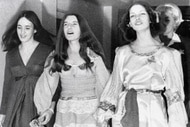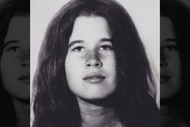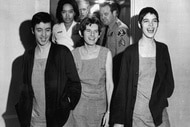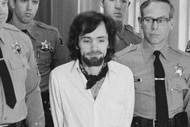Create a free profile to get unlimited access to exclusive videos, breaking news, sweepstakes, and more!
New Sketch Released Of Unidentified "Candy Man" Murder Victim as Authorities Scramble to Identify the Teen
“We remain hopeful that this young man’s family and friends are still looking for him,” the National Center for Missing and Exploited Children said in a statement.

A newly released image of an unidentified teenage murder victim, who was killed in the 1970s by the sadistic serial killer known as the "Candy Man," has reignited interest in the mass murders.
This month, officials released the first-known image of the nameless teenage victim who was murdered by Dean Corll 50 years ago in the hopes of identifying the boy after he was found murdered in Houston.
In the early 1970s, Corll murdered at least 28 teenage boys and young men in the Houston and Pasadena areas of Texas. The gruesome set of killings and sexual assaults, which came to be known as the “Houston Mass Murders,” was then the deadliest serial killing incident in the country. Corrll was dubbed “The Candy Man" because he was known to give kids treats from his family's candy factory, according to Texas Monthly.
RELATED: The River Valley Killer, Ted Bundy, And More Serial Killers Who Terrorized The South
All but one victim was identified. The teen in question, whom investigators suspect was between 15 and 18 years old at the time he died, had been dead for likely a year or more prior to detectives uncovering his remains. The young man suffered from a mild form of spina bifida, which affects the spine, officials said. The condition may have given him lower back pain or it could have affected his walking pattern, experts said.
For the first time ever, forensic artists with the National Center for Missing and Exploited Children (NCMEC), in conjunction with the Harris County Institute of Forensic Sciences, published a new reconstructed illustration this week of how the unknown victim may have appeared prior to his murder.
“At the National Center for Missing & Exploited Children, we have seen incredible things happen in long term cases,” Angeline Hartmann, the communications director at the center, told Oxygen.com in a statement on Wednesday.
“Even after five long decades, we know that this case can be solved, especially now, with these brand-new images. Someone out there can recognize these big clues. Now, the key is to share these images and we're asking everyone to help us do that.”
Investigators describe the teen as white with brown hair roughly seven-inches in length, per a medical examiner’s report. At the time of his death, the John Doe was wearing belted Catalina swim trunks with vertical red, turquoise, gold, and dark blue stripes, according to the National Center for Missing and Exploited Children. The letter "C" was imprinted into the center of the wings on the swimming trunks' silver buckle.
The victim was also wearing cowboy boots with the words “NEOLITE” on the heel. A knotted leather ankle bracelet and dark blue corduroys were found with his remains.
RELATED: 13 Serial Killers Who Turned Their Homes Into Torture Chambers
Corll was often assisted in his grisly acts by two teens, David Brooks and Elmer Wayne Henley. On August 8, 1973, Corll was gunned down by Henley, who told police he pumped six bullets into the electrician in self-defense.
Henley and Brooks would ultimately go on to expose Corll’s wicked deeds, taking law enforcement to multiple makeshift graves across Houston where the serial killer dumped countless bodies. The victims, ranging in age from 13 to 20, came to be known as “The Lost Boys.” Many were snatched in broad daylight.
Henley and Brooks admitted to recruiting victims, who were often their friends, for Corll, who paid them $200 per person, according to the National Center for Missing and Exploited Children. The pair later pleaded guilty and were subsequently sentenced to life in prison. In 2020, Brooks died in prison from complications caused by COVID-19. Henley remains behind bars, after numerous failed parole attempts.
“We remain hopeful that this young man’s family and friends are still looking for him,” said Carol Schweitzer, supervisor of the NCMEC’s Forensic Services Unit. “He may have siblings, cousins, classmates, neighbors or friends that have always wondered what happened to him. This young man’s friends and classmates would be in their late 60s to early 70s and we hope that this new imagery reaches them and helps bring in that one single lead needed to resolve this case.”
Anyone with additional information pertaining to the case is urged to contact the Harris County Institute of Forensic Sciences at 713-796-6858. Tips can also be submitted by calling 1-800-843-5678.




























